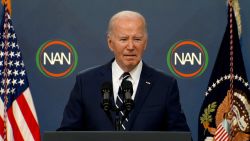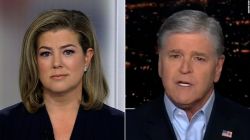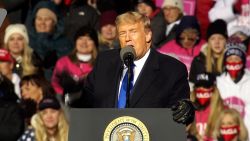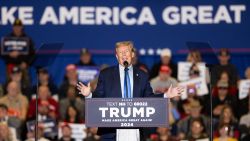President Donald Trump said Tuesday that the administration is looking at possible tax cuts, but reiterated that the US economy is still growing and remains very far from a recession.
“We’re looking at various tax rate deductions but I’m looking at that all the time … that’s one of the reasons we’re in such a strong economic position. We’re, right now, the No. 1 country anywhere in the world by far as an economy,” Trump told press during a White House meeting with Romanian President Klaus Iohannis.
“Payroll tax is something that we think about and a lot of people would like to see that, and that very much affects the workers of our country,” Trump said, but cautioned that he’s “not looking to do anything at this moment” as it relates to those potential tax cuts.
But despite Trump’s public-facing vociferousness about the strength of the economy on his watch and aides stating they have no concerns about a recession, officials have discussed the possibility of a potential payroll tax cut to stave off anxiety over an economic slowdown in recent days.
The President’s robust take on the economy has been somewhat undercut in recent weeks. One indicator, the bond market yield curve inversion, went upside-down briefly last week, suggesting that a recession may be looming. And US Steel, part of the American steel industry the Trump administration has been trying to save through tariffs, has announced it would temporarily be laying off about 200 workers.
Multiple senior officials told CNN they weren’t aware of the payroll tax break discussions – revealing what an early stage the talks have been in.
The Washington Post first reported the talks Monday.
A White House official denied to CNN on Monday that the move was under consideration “at this time.”
“As Larry Kudlow said yesterday, more tax cuts for the American people are certainly on the table, but cutting payroll taxes is not something under consideration at this time,” the official said in a statement.
The US has continued to see positive economic growth and a hot job market, thanks in part to Trump’s 2017 tax cuts, but that’s been largely driven by consumer demand that could be dashed by a slowdown abroad.
Tax policy analysts argue the timing of a payroll tax cut when unemployment is at a historic low and the economy is on solid ground would be a waste of ammunition in the event of a future downturn.
“There’s no economic reason for it right now. Unemployment is extremely low and the economy is slowing a little bit, but it’s slowing from an artificially higher rate from the last round of tax cuts,” said Benjamin Page, a senior fellow at the non-partisan Tax Policy Center.
During a downturn, administrations have used one-time tax credits, like former President George W. Bush did in 2001, which deployed rebate checks of up to $600 to Americans.
The Trump administration would also need the support of Congress to make such a change, which analysts suggest might be difficult in the Democratically controlled House.
Millions of American employees pay 6.2% of their salary in “payroll taxes,” which are usually used to fund social safety net programs – such as Social Security and Medicare.
It would not be the first time a sitting president has used it as a political maneuver.
Former President Barack Obama, seeking reelection, signed a law in 2012 extending a payroll tax cut for workers and unemployment benefits as part of the administration’s economic recovery plan following the financial crisis.
Rather than paying a 6.2% payroll tax, they paid 4.2%, putting an extra $83 a month in the pockets of American workers making $50,000, for example.
Payroll tax cuts, like all tax cuts, grow the deficit in the short term. But they are appealing to aides worried about a potential recession because they are widely popular and are designed to boost American spending, which accounts for about two-thirds of the economy.
“A payroll tax would definitely reduce federal revenue and add to the federal deficit,” Kyle Pomerleau, chief economist at the Tax Foundation, told CNN.
The country’s debt has been piling higher under the Trump administration in part due to a $1.5 trillion tax cut signed into law in 2017 along with a massive spending package passed by Congress.
Trump promised during the 2016 election to eliminate the federal debt.
The White House’s Office of Management Budget has predicted that the deficit will exceed $1 trillion for the entire fiscal year, which ends on September 30. The nonpartisan Congressional Budget Office in May had predicted a slightly smaller shortfall of $896 billion for the year, with deficits rising above $1 trillion starting in 2022.
CNN’s Jim Acosta and Veronica Stracqualursi contributed to this report.




















